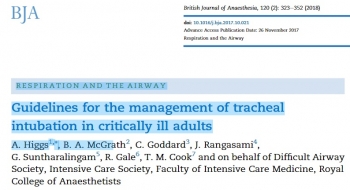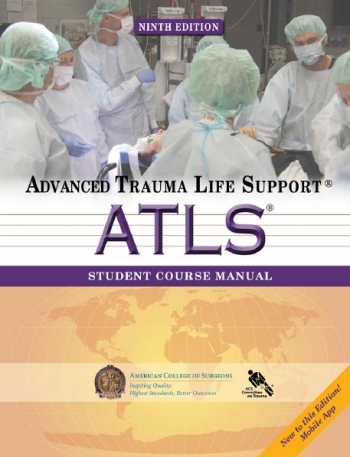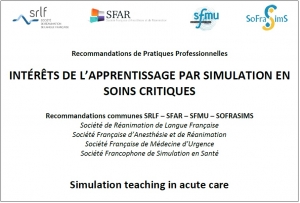27/03/2019
Management of tracheal intubation in critically ill adults
| Tags : airway
19/03/2019
ATLS 9ème Edition
Trauma et formation: Progrès encore à faire
Surgical interns in 2018: Objective assessment suggests they are better but still lack critical knowledge and skill.
BACKGROUND:
The transition from fourth-year medical student to surgical intern is difficult. A lack of repetitions, experience, and knowledge is problematic. We report our experience using simulation-based technical and nontechnical skills to assess the competency of surgical interns in July and January of their intern year.
DESIGN:
As part of a larger assessment effort, our general surgery interns (2010-2016) have been tested on performing an emergent cricothyrotomy, interpreting 2 arterial blood gases, and reading 3 chest x-rays in fewer than 7 minutes. We retrospectively analyzed general surgery interns' performance on these 3 tests (total score = 20).
RESULTS:
A total of 210 interns completed both July and January (identical) assessments. Overall mean scores improved from July (12.62 ± 3.44) to January (16.5 ± 2.46; P < .05). During the study period general surgery interns' mean baseline scores improved in both July (P < .05) and in January (P < .05). Although most individual general surgery interns did improve their total scores (92% improved, 3% same, 5% worse) between July and January (P < .05), in January 40% could not perform an emergent cricothyrotomy swiftly, and 6% missed a tension pneumothorax on chest x-ray.

CONCLUSION:
Our data suggest that surgical interns start residency training with low levels of skill and comprehension with emergent cricothyrotomy, arterial blood gas, and chest x-ray. They improve with 6 months of clinical and simulation training. Encouragingly, overall scores for both July and January assessments have improved during the study period. Given that some interns still struggle in January to perform these three tasks, we believe that 2018 interns are better, but still potentially lack critical knowledge and skill.
16/03/2019
Irak/Syrie: Quelle activité ?
The First 30 Months Experience in the Non-Doctrinal Operation Inherent Resolve Medical Theater
Schauer SG et Al. Mil Med. 2018 Nov 5. doi: 10.1093/milmed/usy273
----------------------------------------------------
Les auteurs rapportent le soutien médical de combats menés essentiellement par des troupes amies. La lecture des fichiers associés à la publication s'impose. Pose de garrot et réchauffement sont les gestes préhospitaliers les plus fréquents. Il faut noter, au niveau des structures chirurgicales la fréquence des drainages thoraciques, des intubations et des laparotomies.
----------------------------------------------------
Introduction:
U.S. military forces were redeployed in 2014 in support of Operation Inherent Resolve (OIR), operating in an austere theater without the benefit of an established medical system. We seek to describe the prehospital and hospital-based care delivered in this medically immature, non-doctrinal theater.
Materials and Methods:
We queried the Department of Defense Trauma Registry (DODTR) for all encounters associated with OIR from August 2014 through June 2017. We sought all available prehospital and hospital-based data.
Results:
There were a total of 826 adults that met inclusion; 816 were from Iraq and the remaining 10 were from Syria. The median age was 21 years and the most frequent mechanism of injury was explosives (47.7%). Median composite injury severity scores were low (9, IQR 2.75-14) and the most frequent seriously injured body region was the extremities (23.0%). Most subjects (94.9%) survived to hospital discharge. Open fractures were the most frequent major injury (26.0%). In the prehospital setting, opioids were the most frequently administered medication (9.3%) and warming blanket application (48.7%) and intravenous line placement (24.8%) were the most frequent interventions. In the emergency department, Focused Assessment with Sonography in Trauma exams (64.3%) was the most frequently performed study and endotracheal intubations were the most frequent (29.9%) procedure. In the operating room, the most frequently performed procedure was exploratory laparotomy (12.3%).
Conclusions:
Host nation military males injured by explosion comprised the majority of casualties. Open fracture was the most common major injury. Hence, future research should focus upon the unique challenges of delivering care to members of partner forces with particular focus upon interventions to optimize outcomes among patients sustaining open fractures.
CASE EVAC/MEDEVAC: Besoin de clarification
A Descriptive Analysis of Causalities Undergoing CASEVAC from the Point-of-Injury in the Department of Defense Trauma Registry
The recent conflicts in Iraq and Afghanistan entail an asymmetric battlefield without clearly defined forward lines of troops as seen in previous wars. Accordingly, the United States military medical services have increasingly adopted casualty evacuation (CASEVAC) platforms. We describe CASEVAC events reported within the Department of Defense Trauma Registry (DODTR).
This is a secondary analysis of previously published data from two datasets spanning from 2007 through 2017. We isolated casualties within our dataset that had a documented evacuation method from the point-of-injury other than dedicated medical evacuation platforms (e.g., MEDEVAC, etc.).
During OPERATION IRAQI FREEDOM, three casualties underwent CASEVAC. The median age was 30 and all were male. Most sustained injuries from explosives (67%) and the median composite injury scores were low (10). The most frequent seriously injured body region was the thorax (67%). All survived to hospital discharge. During operations in Afghanistan (OPERATION ENDURING FREEDOM, OPERATION FREEDOMS SENTINEL, OPERATION NEW DAWN), 248 casualties underwent CASEVAC. The median age was 28 and most (96%) were male. Most sustained injuries from explosives (58%) and the median injury score was low (9). The most frequent seriously injured body region was the extremities (24%). Most (97%) survived to hospital discharge. During OPERATION INHERENT RESOLVE, 247 casualties underwent CASEVAC. The median age was 21 and most (96%) were male. The majority sustained injuries from explosives (61%) and the median injury score was low (9). The most frequent seriously injury body region was the extremities (27%). Most survived to hospital discharge (94%).
In our dataset, CASEVAC events most frequently involved US military personnel service members with most surviving to hospital discharge. Developing new terminology that distinguishes different types of CASEVAC would allow for more accurate future analyses of casualty evacuation and outcomes – such as those transports that are truly in a non-medical versus the various medical platforms that do not fall with into the confines of the MEDEVAC platforms.
ALR en opex: 1 formation solide est nécessaire
Regional Anesthesia in the Combat Setting: Are ACGME Requirements Enough?
Dhanjal ST et Al. Mil Med. 2019 Feb 22. pii: usz007. doi: 10.1093/milmed/usz007
----------------------------------
Il existe un grand engouement pour la réalisation d'ALR pour la prise en charge de la douleur des blessures de guerre. Ces techniques, dont certaines sont simples, nécessitent cependant un apprentissage dont la charge est probablement sous estimée. C'est ce qu'illustre ce travail pourtant effectué dans une population censée en maîtriser tous les aspects.
----------------------------------
Updated Joint Trauma System Clinical Practice Guidelines (CPG) indicate regional anesthesia and pain management (RAAPM) are important for combat casualty care. However, it is unclear whether military anesthesiology residents are receiving adequate RAAPM training to meet the CPGs. The goal of this study was to conduct a preliminary evaluation of resident-completed combat-relevant regional anesthesia procedures. It was hypothesized that most residents would perform an adequate number of each procedure to presume proficiency.
Resident-performed, combat-relevant regional anesthesia procedure frequency was extracted from a database maintained at a military anesthesiology residency program. Data collection was limited to a 1-year period. Univariate statistics described procedure distributions, frequencies, and proportion of residents achieving pre-defined, empirically-supported experience criteria for each technique. Analyses examined proportional differences in meeting experience criteria by training-year.
Residents (N = 41) performed a variety of procedures. Simple procedures, such as saphenous peripheral nerve blocks, were performed at a greater frequency than more complicated procedures such as thoracic epidurals, continuous peripheral nerve blocks, and transverse abdominus plane blocks.

The majority of residents met experience criteria for four out of the eight measured combat-relevant blocks. There were no proportional differences in meeting procedural experience criteria across the different training levels.
These results suggest a possible gap between the needs of the Military Health System during conflict and current residency training experiences. Reasons for this gap, as well as solutions, are explored.
Reco Simulation
15/03/2019
Encore à la recherche d'un simulateur de crico
A trial comparing emergency front of neck airway performance in a novel obese-synthetic neck, meat-modified obese neck and conventional slim manikin.

11/03/2019
Sang total de banque: Oui mais avec une logistique adhoc
The use of whole blood in US military operations in Iraq, Syria, and Afghanistan since the introduction of low-titer Type O whole blood: feasibility, acceptability, challenges.
------------------------------
L'emploi de sang total est redevenu d'actualité, qu'il s'agisse de sang prélevé sur pied ou conservé en banque. Ce dernier est de plus en plus employé, notamment en role 2, avec cependant une difficulté qui tient à une moindre durée de conservation (21 jours en poche CPD et 35 jours en poche CPDA-1). Réduire le délai prélèvement-délivrance sur zone est donc fondamental si l'on souhaite en tirer le meilleur bénéfice. La production sur zone de combat de ce type de produit pourrait être une solution.
------------------------------
BACKGROUND:
Hemorrhage is the leading cause of preventable death in military and civilian traumatic injury. Blood product resuscitation improves survival. Low-titer Type O Whole Blood (LTOWB) was recently re-introduced to the combat theater as a universal resuscitation product for hemorrhagic shock. This study assessed the utilization patterns of LTOWB compared to warm fresh whole blood (WFWB) and blood component therapy (CT) in US Military Operations in Iraq/Syria and Afghanistan known as Operation Inherent Resolve (OIR) and Operation Freedom's Sentinel (OFS) respectively. We hypothesized LTOWB utilization would increase over time given its advantages.
STUDY DESIGN AND METHODS:
Using the Theater Medical Data Store, patients receiving blood products between January 2016 and December 2017 were identified. Product utilization ratios (PUR) for LTOWB, WFWB, and CT were compared across Area of Operations (AORs), medical treatment facilities (Role 2 vs. Role 3), and time. PUR was defined as number of blood products transfused/(number of blood products transfused + number of blood products wasted).
RESULTS:
The overall PUR for all blood products was 17.4%; the LTOWB PUR was 14.3%. Over the study period, the total number of blood products transfused increased 133%. Although the total whole blood (WB) increased from 2.1% to 6.6% of all products transfused, WFWB use remained at 2% while LTOWB transfusions increased from 0.5% to 4%. Transfusion of LTOWB occurred more in austere Role 2 facilities compared to Role 3 hospitals.
CONCLUSIONS:
LTOWB transfusion is feasible in austere, far-forward environments. Further investigation is needed regarding the safety, clinical outcomes, and drivers of LTOWB transfusions.
10/03/2019
Garrot jonctionnel: Pas si performant que cela !
Comparison of Three Junctional Tourniquets Using a Randomized Trial Design.
BACKGROUND:
Hemorrhage remains a leading cause of death in both civilian and military settings. Of preventable deaths from hemorrhage, a significant portion occurs from junctional wounds that are not amenable to traditional extremity tourniquets. Junctional tourniquets (JTQs) can potentially provide hemorrhage control by compressing the arteries at the junction of the trunk and extremities. The FDA has cleared 3 JTQ products: The Combat Ready Clamp (CRoC®), the Junctional Emergency Treatment Tool (JETT™), and the SAM® JunctionalTourniquet (SJT). However, little is known regarding which of these JTQs is superior in application time, effectiveness in pulse elimination, effectiveness during transport, and user preference.
METHODS:
Active duty corpsmen (N = 49) were given standardized instruction and hands-on training with the CRoC®, JETT™, and SJT, then sequentially applied each JTQ unilaterally to a fellow study participant in a randomized order. Pulse elimination was determined by Doppler ultrasound at the dorsalis pedis immediately then reevaluated after a short transport. User preference data were collected following testing. Data were analyzed using repeated measures ANOVA and non-parametric statistics at p < 0.05.
RESULTS:
The CRoC® was significantly slower in application time than the JETT™ and SJT. Effectiveness was similar for CRoC®, JETT™, and SJT. Effectiveness during transport was significantly higher for SJT than for the JETT™, but no JTQ performed well during transport (24-48% effectiveness).

SJT ranked first in perceived ease of use, stability, and reliability, and in user trust and overall preference. Participants provided cogent suggestions for product improvement.
CONCLUSIONS:
All JTQ devices performed poorly during transport. Combined, present findings highlight the potential of JTQ products for saving lives threatened by junctional wounds, but also highlight the need for specific product improvements towards fostering JTQ performance in patient transport.
| Tags : jonctionnel
08/03/2019
Recommandations vaccinales 2022
05/03/2019
Module de chirurgie vitale: Bilan
Deployment of the Surgical Life-saving Module (SLM) in 2017: lessons learned in setting up and training operational surgical units
Malgras B et Al. https://doi.org/10.1016/j.injury.2019.03.001
Introduction
The military operations carried out by the French armed forces, occasionally require the use of the Surgical Life-saving Module (SLM), to ensure the surgical support of its soldiers. Due to its extreme mobility and capacity of fast deployment, SLM is particularly useful in small-scale military operations, such as Special Forces missions. In 2017, the French SLM was for the first time used to ensure surgical support of allied forces, which were lacking forward surgical capabilities.
Materials and Methods: the SLM is a mobile, heliborne, airborne, surgical structure with parachuting capability onto land or sea, therefore essentially focused on life-saving procedures, also known as "damage control" surgery. Due to the need for mobility and rapid implementation, the SLM is limited to a maximum of 5 interventions or, in terms of injuries, to 1 or 2 seriously injured patients.
Results
Over a period of 2 months, 5 medical teams were successively deployed with the SLM. A total of 157 casualties were treated. The most common injuries were caused by shrapnel 561%), followed by firearms (36%), and blunt trauma (2.5%). Injuries included the limbs (56%), thorax (18%), abdomen (13%), head (11%), and neck (2%). The average ISS was 8.5 (1-25) with 26 patients presenting with an ISS greater than or equal to 15. The average NISS was 10.8 (1-75) with 34 casualties having an NISS equal to or greater than 15. The surgical procedures were broken down as follows: 126 dressings, 16 laparotomies, 7 thoracotomies, 12 isolated thoracic drains (without thoracotomy), 1 cervicotomy, 12 amputations, 7 limb splints, 2 limb fasciotomies, 2 external fixators and 1 femoral fracture traction.
Conclusions
The numerous SLM deployments in larger operations highlighted its ability to adapt both in terms of equipment and personnel. Continuous management of equipment logistics, robust personnel training, and appropriate organization of the evacuation procedures, were the key elements for optimizing combat casualty care. As a consequence, the SLM appears to be an operational surgical unit of choice during deployments.
04/03/2019
Transfusion: Numéro spécial Trauma
03/03/2019
Crico: Simulation classique = Haute fidélité
A high-fidelity simulator for needle cricothyroidotomy training is not associated with increased proficiency compared with conventional simulators: A randomized controlled study.
BACKGROUND:
A high-fidelity task simulator for cricothyroidotomy was created using data from a 3-dimensional (3D) computed tomography scan using a 3D printer. We hypothesized that this high-fidelity cricothyroidotomy simulator results in increased proficiency for needle cricothyroidotomy compared with conventional simulators.
METHODS:
Cricothyroidotomy-naive residents were recruited and randomly assigned to 2 groups, including simulation training with a conventional simulator (Group C) and with a high-fidelity simulator (Group 3D). After simulation training, participants performed cricothyroidotomy using an ex vivo porcine larynx fitted with an endoscope to record the procedure. The primary outcomes were success rate and procedure time. The secondary outcome was a subjective measure of the similarity of the simulator to the porcine larynx.
RESULTS:
Fifty-two residents participated in the study (Group C: n = 27, Group 3D: n = 25). There was no significant difference in the success rate or procedure time between the 2 groups (success rate: P = .24, procedure time: P = .34). There was no significant difference in the similarity of the simulators to the porcine larynx (P = .81).
CONCLUSION:
We developed a high-fidelity simulator for cricothyroidotomy from 3D computed tomography data using a 3D printer. This anatomically high-fidelity simulator did not have any advantages compared with conventional dry simulators.
| Tags : airway, coniotomie





